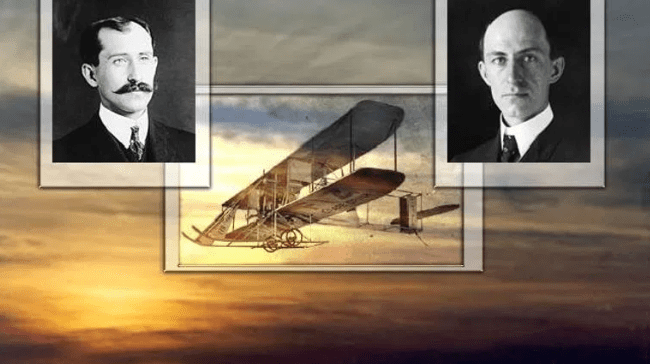On the morning of December 17, 1903, near Kitty Hawk, North Carolina, the Wright brothers achieved a remarkable feat—the first sustained, controlled, powered flight of a heavier-than-air aircraft. The Wright Flyer, piloted by Orville Wright, flew 120 feet in 12 seconds. This short journey was the culmination of years of curiosity, experimentation, and persistence by the Wright brothers as they aspired to achieve human flight.
The Wright brothers’ monumental success was not an overnight windfall, but rather the product of diligent scientific thought experiments and methodical testing of theories. Their story emphasizes the immense power of human creativity and intellect to push boundaries and bring about innovation.
Brothers Orville and Wilbur Wright grew up in Dayton, Ohio in the late 19th century. From an early age, they were fascinated by engineering and mechanics. As young men, they opened a bicycle repair shop while continuing to nurture their passion for solving the puzzle of mechanical flight.
Orville and Wilbur Wright were not just inventors; they were visionaries. Growing up in a household that encouraged curiosity and intellectual exploration, they developed a passion for mechanics and engineering. Their journey towards the first successful flight was not a linear path but a winding road filled with trials, errors, and breakthroughs.

The Wright brothers recognized that the conventional wisdom around flight at the time was flawed. Scientists did not fully understand aerodynamics and bird flight. Instead of blindly accepting existing theories, the Wright brothers drew upon their creativity to conduct thought experiments about the fundamentals of aerodynamics and control. They tested and challenged assumptions through intellectual exploration. Their ability to question established ideas and approach problems from new perspectives was critical to their eventual success.
The Wright Brothers began by dissecting the problem of flight into its fundamental components. They realized that control, rather than mere lift, was the key to successful flight. They observed birds in flight, understanding how they used their wings to control their movement. This observation led to the concept of wing-warping, a critical breakthrough in flight control.
The brothers laid the foundation for their groundbreaking work by comprehensively studying aeronautics history and fundamentals. Through extensive reading and correspondence with other pioneers like Otto Lilienthal and Octave Chanute, they understood past efforts and failures. They also deeply researched the physics and mechanics of aerodynamics and lift. This scientific knowledge, combined with their practical experience building bicycles, gave them a solid base. Their systematic study of aviation history and principles allowed the brothers to effectively target their research on the core innovative areas needed to achieve flight.
They recognized that birds had effectively solved the puzzles of lift, drag, and flight control through millennia of evolution. By watching soaring and gliding birds like hawks, seagulls, and pigeons, the brothers gained crucial insights into aerodynamics and achieving lift without excessive engine power. They also studied how birds used their wings and bodies to steer and maintain stability in the air. The Wright brothers then translated these biological observations into engineering principles that informed their wind tunnel experiments and aircraft prototypes. Their careful study of nature provided important clues that advanced their understanding of aerodynamics far beyond what pure theory had achieved.
The brothers were meticulous experimenters who tested numerous iterative designs. Starting in 1899, they began testing model kites and unpowered gliders near Kitty Hawk, North Carolina. Over the next three years, they conducted between 500-1,000 glide tests. They actively tweaked each prototype design based on observation and data from previous iterations. This incremental testing approach allowed them to systematically identify and solve aerodynamic problems one at a time. For example, their 1902 glider incorporated longer wings and a rear rudder based on lessons from earlier models. The brothers saw each failure and prototype as a stepping stone. By methodically testing and tweaking designs, they crept closer to the elusive goal of controlled, powered flight.
Many early flight pioneers focused their efforts on developing more powerful gasoline engines, assuming that engine power was the key to achieving flight. The Wright brothers took a different approach as they believed conventional thinking about flight was flawed. Rather than focus on the engine, they realized that the wings and control surfaces were more critical. Based on their testing observations, the brothers understood that without proper wings and aerodynamic control, increasing engine power alone was useless. By challenging the conventional wisdom that dominated flight research at the time, the Wright brothers were able to target their research efforts on tackling the core technical issues of lift, drag, and control. Their out-of-the-box thinking was foundational to their eventual success.
They challenged existing theories, such as the Smeaton coefficient, and developed their own aerodynamic principles. They integrated their discoveries into a cohesive design, leading to the creation of the first successful powered aircraft.
Despite numerous setbacks and skepticism from the scientific community, they remained committed to their vision, driven by curiosity and determination. The brothers worked closely together, sharing ideas and insights, fostering a collaborative environment that fueled their creativity.
Though deeply passionate about scientific discovery, the Wright brothers also struggled with the potential ethical implications of their inventions. As their aircraft designs rapidly advanced after their initial success in 1903, the brothers became concerned that their innovations could be used to create powerful weapons of war. At a time before any meaningful international arms control existed, Wilbur and Orville worried about the potential loss of innocent lives from aerial bombs. As a result, they became more protective of their later patents and selective about publicly sharing details of their designs. Though the Wright brothers eagerly pursued more knowledge, they balanced their idealism with ethical considerations. Their thoughtful moral deliberations led them to exercise discretion for the greater good as their aircraft neared military applicability.
The brothers exemplified the grit and determination necessary to turn aspirations into reality. Lack of funds could have prevented progress. But through it all, the Wright brothers persisted with tireless resilience. They never lost faith in their goals and abilities. The brothers pressed on when it would have been easier to quit. Their eventual triumph over years of adversity showed the power of resilience when fused with passion. Though genius provided the spark, it was the Wright brothers’ grit that carried them through failure after failure until they finally tasted hard-earned success. Their story inspires resilience in all who come after.
The brothers demonstrated the power of multidisciplinary thinking by thought experiments, and blended insights from biology, engineering, and aeronautics. At a time when most pioneers were trapped in the narrow view of powered flight as an engineering challenge, the Wright brothers took a systems approach. By leveraging mechanical engineering principles, they created controlled prototypes. The range of the Wright brothers’ thinking allowed them to achieve a complex goal that narrow engineering approaches had failed to reach. Their pioneering of powered flight exemplified how groundbreaking advances often occur at intersections between disciplines.

The Wright brothers’ monumental achievement was not an overnight accident, but the result of years of passionate inquiry, experimentation, and resilience. Their story serves as a timeless reminder of the immense power of human creativity when coupled with persistence.
By questioning conventional wisdom and approaching problems with childlike curiosity and imagination, we can break boundaries today. We can choose to embrace failures as learning opportunities. And we can find inspiration in the way the Wright brothers thought process utilized various forms of observation, physics and experimentation to all coelese as one amazing scientific accomplishment.
In just 65 short years, humanity soared from the humble beginnings of the Wright brothers’ first flight to the astounding achievement of landing on the moon, all while filling the skies with commercial airlines. This breathtaking journey is a testament to the boundless creativity and relentless innovation that defines the human spirit!






